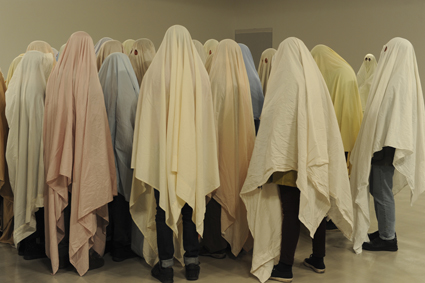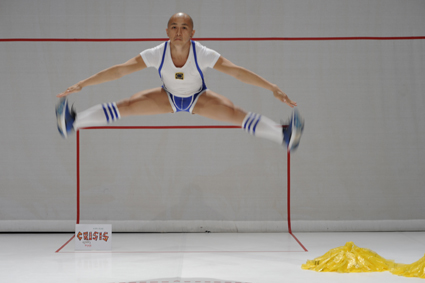Holy Sheet & the collective choreographic consciousness
Julie-Anne Long: Luke George, Daniel Kok

Luke George, Not About Face
courtesy Campbelltown Arts Centre
Luke George, Not About Face
The audience is ushered into an empty white gallery and, as with preparations for a kids’ game, we are assisted in putting sheets over our heads. Before long I stand among an assembly of ghosts in hues of pistachio, lilac, blush and fawn. The intention may be anonymity but I feel self consciously recognisable. The friend who has accompanied me is unaccustomed to the independent dance scene, though familiar with the protocols of theatre and the gallery. He chooses to pull his beanie over his bed(sheet) head and takes a series of photos on his iPhone—we are in a gallery after all.
All I can do is fidget, finding ways to wear my shroud: air underneath, shaping from outside, gather in, smooth over, endless methods in an attempt to get comfortable, in order to concentrate on the performance. Some audience members adjust themselves in a similar manner, while a few renegade spirits slouch against the walls. The majority follow the leader leaning into the alabaster ghost in the centre of the gallery.
There is something in the air of Not About Face as Luke George directs us to press harder, feel the vibrations between us and shake with him. Like a corporealist evangelist he passionately intones about bodily fluids, saliva and brain cells, bringing our attention to the aura that is so close “I could be you and you could be me.” I recognise the zeitgeist, a collective choreographic consciousness characterised by throwaway yet earnest detachment between the flesh performing and the bodies watching—through their Casper eyeholes. Still covered in their sheets his audience curls up on the floor ‘spooning’ each other. Unlike George and most of the audience, I don’t want intimacy, collective desire or to vibrate together. Tonight I don’t feel empathy. I feel coerced and I’m not in the mood for post-irony. Nearing the end, George discards his shroud and dances ecstatically in a skimpy lycra wrestling unitard. Like a charismatic preacher George’s dancing does tap into a collective consciousness of bodies and flesh. His moves are an interesting mix of brittleness and assurance. I enjoy the exuberance of the dance. This part of the experience does affect me and I am left in a state of agreeable bemusement.
Coming out from under our hot shrouds we enjoy the relief of the cool night air before shuffling into the Performance Studio for the second work of the evening, Cheerleader of Europe. The lights shine down on the audience. This is one of those theatrical settings where you feel implicated, in quite a different way from the earlier work. You can’t hide under your sheet, nor sit there in the dark, or relax and do nothing.

Daniel Kok, Cheerleader of Europe
courtesy Campbelltown Arts Centre
Daniel Kok, Cheerleader of Europe
The compact Daniel Kok, from Singapore, wearing the second lycra wrestling unitard of the evening, charms us with a tragic ‘true’ tale of army cadets and a fatal shooting, followed by a chirpy cheerleading routine. Hand coloured flags and “Song of Joy” set the scene for ruminations on the European Project. Once again there is dancing flesh and a proclamation, “My body is right here in front of you…the organs in between…with toes to live the dream…” Once again hints of the collective choreographic consciousness pervade the half-hearted if entertaining movement vocabulary. The manipulative, smooth, dictatorial tone serves as a complementary accumulation to the evangelical voice of the first work.
An awkward apolitical conversation with an audience member who lives here and is ‘European’ ensues. Banal questions such as “Do you feel Australian?” offer little in the way of enlightenment for this audience as to our position in the world. In between, Kok offers apologetically, “I don’t want to put you on the spot.” My European friend mutters, “Well you did,” and I laugh under the bright light. Other than a short, sketchy, informal introduction where he informs us of the previous context for this work, Daniel Kok hasn’t rethought the purpose of this performance, originally for a European audience, in its recasting for an audience in Greater Western Sydney, Australia.
I look for guidance as to how I should respond to these performances. A list in the Program Notes categorises “4 Levels of Engagement in a Performance” (Kok). I take on the advice, as it appears that I am a “meta-critical,” “critical spectator” “engaged in pluralist and agonistic audienceship!” Both works overtly deal with “the nature of the unseen and unspoken agreements/traditions between performer and audience” (George). While George remonstrates with the audience if they don’t do what he wants, Kok “wishes to marshal the community towards a sense of unity” where “everyone must be happy in the end.”
“Come on, do something. We are from Europe,” Kok cheers. “We are from Europe,” he urges us to chant. I can’t summon up the puff to make any sound but my friend sitting next to me, repeatedly utters in his gravelly Eastern European accent: “We are NOT from Europe, We are NOT from Europe. We are NOT from Europe.” Now, in the end, as confetti falls, Kok gets his wish. I am happy. But I am happy that we are NOT from Europe.
Luke George, Not About Face; Daniel Kok, Cheerleader of Europe; Campbelltown Arts Centre, NSW, 1-2 Aug
RealTime issue #123 Oct-Nov 2014 pg. 26






